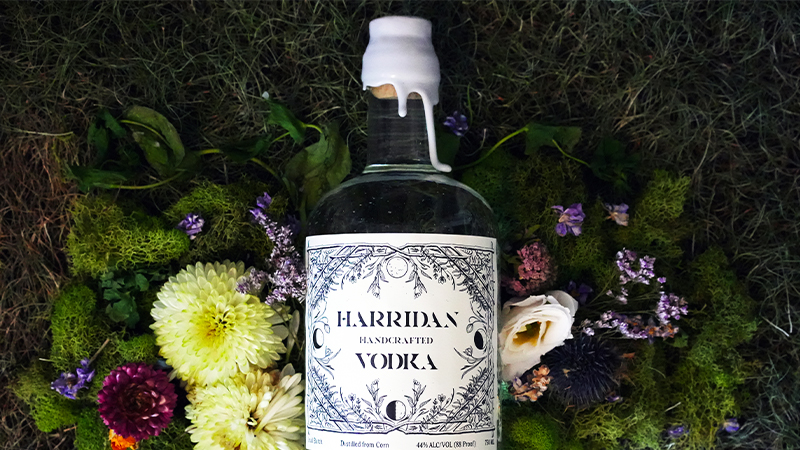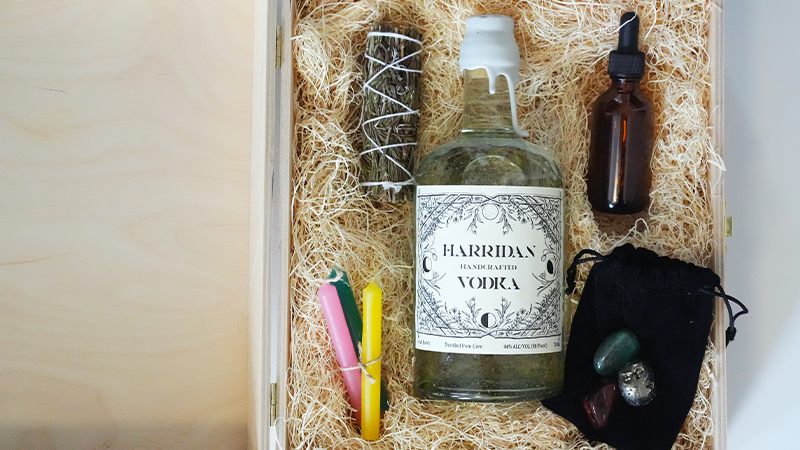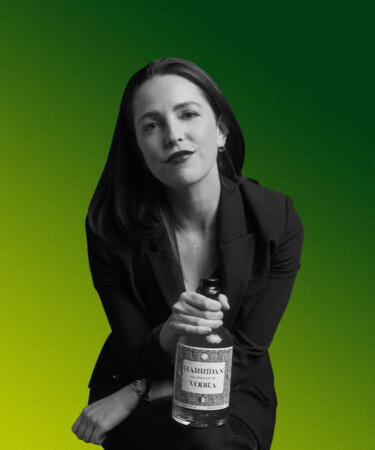Founding a premium vodka brand wasn’t initially in Bridgette Taylor’s crystal ball.
On the precipice of graduating from the Harvard MBA program, Taylor had a job lined up in a completely different field, management consulting. But as many experienced in April 2020, Taylor received a call saying her initial September start time was being pushed back to January 2021, leaving her with no job and nothing to do for the next nine months. During her studies, Taylor became obsessed with making lavish and intricate drinks for her friends and slowly sipping on bourbon and tequila, but at the time, it was just a hobby.
“I thought that I should try starting my own company — vodka has really stood out to me as a category that can use a shake-up, so why don’t I try creating a vodka that could shake up the category?” says Taylor. “What started off as a project to keep me busy as I waited for my full-time job to start just became a total obsession. Now, it’s the passion of my life.”
At Taylor’s Harridan Vodka, super-premium meets supernatural. Combining Taylor’s love for medieval history, the lore of witchcraft, horror movies, and mixology, Harridan has become a brand that goes against the grain, focusing on small production, storytelling, and raising vodka to the craft standards of other categories like whiskey and tequila.
The word “harridan” means an angry, belligerent old woman, typically used to describe witches — Taylor chose it because it “goes very against that idea of pink and flowery stereotypical female aesthetic out there.” Her brand, while female-focused, has gained press for its grittier aesthetics: Its first limited Halloween launch, the Paranormal Reserve, placed hundreds of vodka bottles in some of the most haunted locations in the United States — the Villisca Axe Murder House, the Trans-Allegheny Lunatic Asylum, and Farm on Round Top Road, which inspired the movie “The Conjuring.”
Taylor spoke to VinePair about the inspirations behind creating such a singular brand, the process of learning the tricks of the spirit industry as an outsider, and why she thinks the premium vodka sector isn’t cursed.
1. What drew you to become interested in mixology while at Harvard Business School?
I have always loved making cocktails for friends. And then when the pandemic hit, I went a little overboard. While other people got really into sourdough bread baking and banana bread making, I was experimenting with crazy simple syrups and making homemade orgeat — just totally took it to the extreme. I got really, really into home mixology, and it just brought me a lot of anxiety relief during the pandemic. It’s a hobby that will probably stay with me for the rest of my life.
I got really into cocktail influencers for inspiration — there are so many fun cocktails that are just complicated enough. I like the ones where you can’t just buy the ingredients and squeeze some fresh lemon juice and call it a day. You have to make crazy stuff.
2. What is it about vodka that stood out to you?
As I was getting really into home mixology during the pandemic, one of the joys was finding interesting craft spirits across categories. I felt like there were all these amazing, ultra-premium craft tequilas, and the same thing with whiskey, gin, and more and more so with rum. When it came to vodka, I would look at the selection and say, “This is all the same stuff that’s been around for 20 years — this is the same stuff that my parents have been drinking for decades.” Early on, vodka stood out for me as a category that could use that same renaissance that had already happened in whiskey and [has] now overtaken tequila and mezcal.
3. What was it like to go to the source and actually create your own product?
It was definitely a learning experience because I did not have any experience in vodka production. The first homework that I did on my own was I tried vodka from pretty much every base possible — everything from corn to wheat to rye to grape to milk to sugar. And from there, I narrowed in on what I wanted my base ingredient to be.
I knew I wanted my distillery to be in New York. I reached out to every New York distillery to see if they would be willing to partner with me on a New York corn vodka. And then, I just started sampling people’s products — a lot of distilleries were not making vodka out of New York-grown corn, which was great because we got to partner on an original recipe rather than just white-labeling an existing product. With the distillery we wound up selecting, they sent us a sample of New York corn vodka, and I did a big blind taste test with my friends and family. We put it against the five incumbent vodka brands that everybody knows — my friends and family were all saying, “Whoa, that one is super different; super interesting.” They loved it.
I got back to the distillery and told them they did a wonderful job and that my friends, my family, and myself loved the liquid and were so excited to get started. The distillery responded by saying, “Oh, oops, we accidentally made that liquid 90 proof. We’re so sorry; we will make sure it’s 80 proof for the final run.” My initial reaction was “No, let’s keep it overproof. Let’s be different — there aren’t that many overproof vodkas on the market and it’s just a further differentiator for us.” And then we decided to make it 88 proof instead of 90 proof just because 88 just felt like a fun number, and that’s what we went with.
4. What have been your biggest inspirations while creating this brand?
First off, I was a medieval history major in college. Harridan’s label is inspired by the borders of medieval texts — because so many people at the time were illiterate, the borders of medieval texts were super intricate to just make people excited to open a book. The Harridan border on our label has all these little Easter eggs in it like daggers and ravens and snakes, just the same way that medieval text did. I never thought that major would ever come in handy, and now it’s the driving inspiration behind the brand!
Outside of the medieval component, the underlying thriving inspiration behind the brand itself is witchcraft in general — both historical and contemporary. That has been a really fun theme to explore with the branding overall. The last thing that’s been an inspiration, at least around the bottle design, has been some of the other great category-redefining brands out there. One example to point out is Patrón — they really, at least in the U.S., were a driver in the creation of the ultra-premium tequila market. I’ve always been an admirer of just what their brand has accomplished, so the glass that we use in our bottle is made in partnership with one of the original Patrón factories — our glass has a really beautiful texture and bubbles that are a bit of a nod to our admiration for Patrón. We’ve also had a lot of fun with the wax seal — there are a couple of iconic brands out there that have amazing wax seals as well. That’s another tribute to some of the great brands of old.

5. What made you decide to lean into witchcraft as Harridan’s driving aesthetic?
I am particularly fascinated by the medieval witch hunts and witch trials that happened from the 14th century up until the 17th century. During that time, there were countless women who were persecuted for no other reason than being different or not being exactly what the patriarchy wanted them to be. I have always been morbidly fascinated by that period of history.
As it pertains to Harridan, in my early research around vodka and the spirits industry more broadly, I started to notice that there was definitely a gender imbalance in the industry — it’s a very male-dominated industry. I knew I wanted my brand to be something that was female-centric. I say “centric” because it is not intended to only be for women; everyone across the gender spectrum can all enjoy good vodka. But I wanted the brand itself to really focus on female stories. I love the idea of the anti-hero, of the witch, and I really wanted that to be our mascot — someone who was different and against what the patriarchy expected them to be.
6. You have experience working in the fashion industry. Do you see any stark similarities or differences between the beverage and fashion industries?
There are amazing similarities and then also some striking differences, which I really appreciate. I think it’s actually one of the reasons that I fell in love with the spirits industry so quickly, because I was able to channel so much of the love that I had from my prior fashion experience. Starting with the similarities, so much about luxury fashion and about spirits is brand storytelling. You want to create this vivid brand world where customers can really get lost. Of course, the liquid has to be good, and same with luxury fashion — the quality of the clothes has to be great. But that’s only one part of building a brand; it is really the stories and the world that you create behind it.
7. Harridan is known for having some pretty haunting launches, like the Paranormal Reserve. What has been the response to them?
I could talk about Paranormal Reserve for hours. We knew we wanted to have a big brand moment around Halloween because our mascot is really a witch, and we lean into a spooky-chic brand aesthetic. We were brainstorming on what we could do for Halloween, and we were spitballing with some creatives who we’re friends with, and they suggested, “What if you took some bottles of vodka to haunted houses?” And it was just this moment of magic where my chief brand officer and I thought that was absolutely brilliant. We expanded on that, thinking, “What if we did a play on aging vodka bottles, not in whiskey barrels or anything like that, but in haunted houses?” It just was a perfect lightning-in-a-bottle scenario that aligned with what our brand really wants to accomplish, which has this sense of novelty and intrigue and an alluring identity, but with something that the masses could find really interesting. The logistics behind it were a bit of a nightmare because we had to drive all these bottles to all these haunted houses, which were terrifying. But then the payoff was so worth it because people were even more excited about it than we expected them to be.
Looking at our broader witchy identity, another time of the year that really stood out to us was the summer solstice, which is a very significant day for any person that practices witchcraft. So we came out with a limited edition and partnered with a famous witch on a special product that could come out during this time. We connected with The Hoodwitch, who is one of the internet’s most famous witches and also just a wonderful person. She gave us a lot of guidance on what type of product we should be coming out with during this time of year. She really emphasized that the summer solstice is a time of abundance and manifesting prosperity — so that detail is what we created our ritual box around. If you wanted to actually manifest prosperity and abundance at home, what would you need? That’s what we decided to put in that ritual box.
The way we divide those tentpole moments is that Halloween is for scary, spooky times, and then midsummer is much more about contemporary witchcraft, and how people can learn about these amazing manifestation and fulfillment practices on their own individual terms.

8. What do you think brands like Harridan bring to the expanding world of premium spirits?
They just bring a different type of story. And with Harridan in particular, we’re trying to be different along every aspect of a spirits brand. We’re trying to taste really different from other vodkas, to look different from other vodkas, to present our brand in a totally different way than what the spirits industry has encountered before. And it’s not that you can’t do this in any tranche of spirit prices, whether that be premium, super premium, or ultra premium, but I think what the ultra-premium category lets you do is really bring this commitment to quality and customer experience.
At Harridan, we’re trying to bring this notion of “made like it used to be,” when there was such a commitment to craft and a time before machines, before everything felt so automated. There was a time when everything had to be crafted by hand. Because it’s “Harridan Handcrafted Vodka,” our commitment to the handcrafted piece is that so many hands touch this bottle before it gets put on the shelf — whether that’s hand-dipping it in black wax; whether that’s making batches of Harridan in these nano-batches of 3,000 bottles or less. It’s just such an intimate experience creating a batch of Harridan. That’s a long-winded way of tying it back to my first point, which is we’re bringing a different type of story or just a different brand to the table, harnessing the highest standards of quality that one would expect from an ultra-premium spirit.
9. What is your vision for the brand’s future?
Our hope for the brand in the future is to bring consumers a new understanding and appreciation for vodka. I want to have a group of customers who are so loyal and excited about Harridan and are saying that this is the vodka that they’ve been waiting for. I’d also love to bring in people who didn’t even know they liked vodka, and then they try Harridan and we win them over to this new type of vodka drinking experience.
In terms of exciting projects, there will be a Paranormal round two — possibly even spookier than our Paranormal round one. We are keeping the exact haunted location under wraps for now, but if you are any horror movie fan, you probably will have heard of it.
10. What are your best tips for anyone looking to start a spirits brand right now?
You don’t have to listen to everybody. Early on, because I was new to the space, I rightfully was asking a ton of people for advice. Before I knew it, it was like someone had spun me around in a circle and then said, “Go build a brand.” I had so many pieces of conflicting advice.
When I first started building Harridan, there was one day where I woke up and said, “Oh my gosh, this isn’t at all what I want to be building.” I didn’t want to be building another $25 vodka that looks like every other vodka out there, because people are telling me that this is the price point that I have to adhere to in order to be successful. At a certain point, if you’re starting a spirits brand and you have a vision, and if that vision is really different from the things on the market, you just have to trust your gut. Just go for it — people will appreciate new stories and a new interpretation of the category. You don’t have to listen to the million people giving you advice on what to do.
This story is a part of VP Pro, our free platform and newsletter for drinks industry professionals, covering wine, beer, liquor, and beyond. Sign up for VP Pro now!
